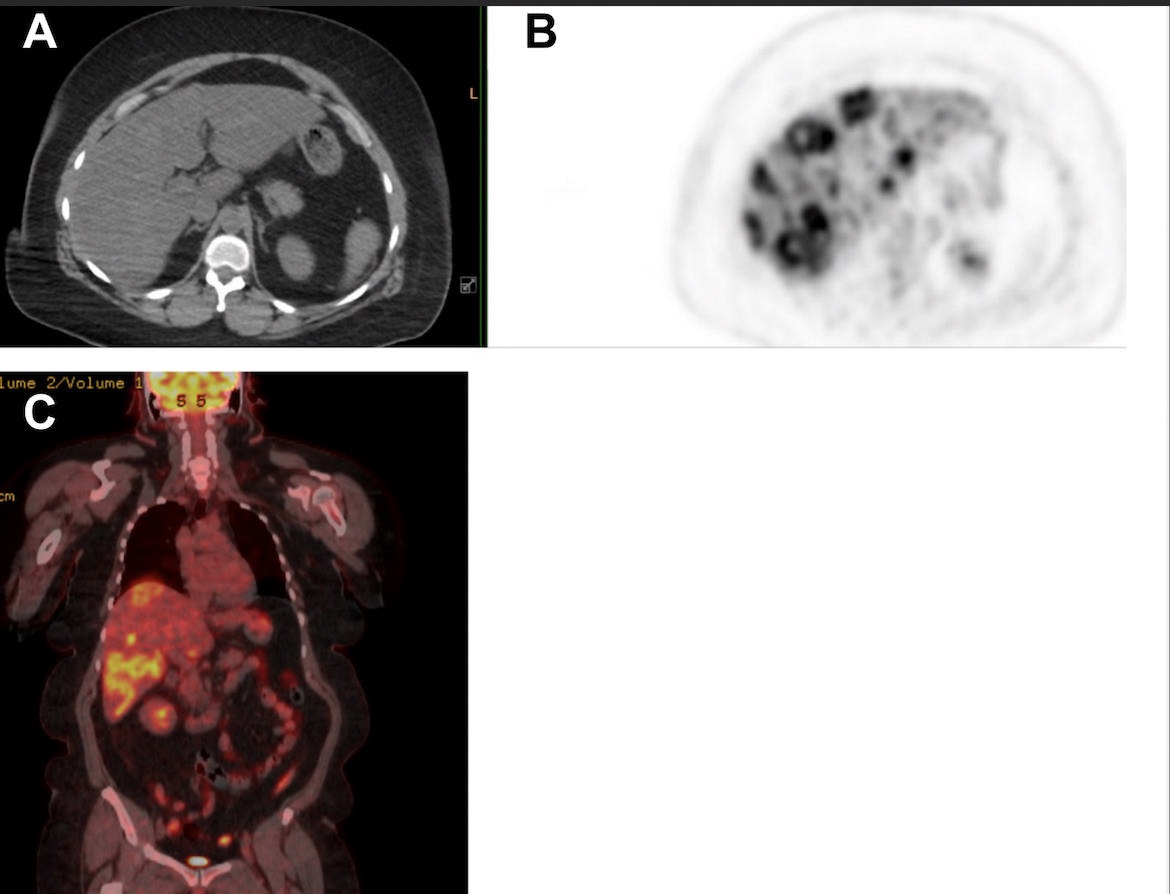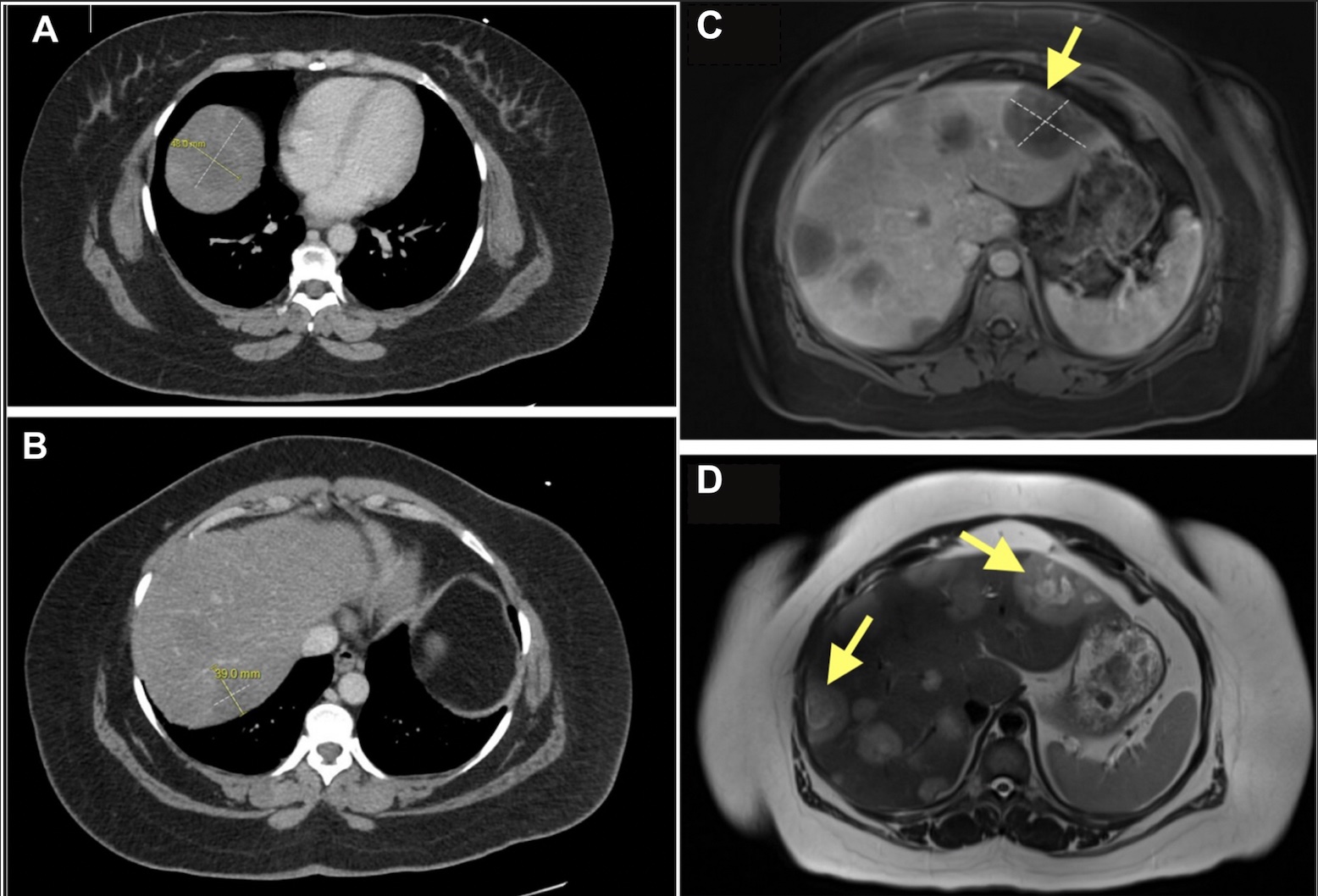Sunday Poster Session
Category: Liver
P1760 - Hepatic Epithelioid Hemangioendothelioma With Lung Metastasis
Sunday, October 26, 2025
3:30 PM - 7:00 PM PDT
Location: Exhibit Hall

Beza M. Mengistu, BS
University of California Los Angeles David Geffen School of Medicine
Los Angeles, CA
Presenting Author(s)
Beza M. Mengistu, BS1, Kelsy N. Larios, BS2, Derin Celtik, BS3, Elvira Rodriguez, NP4, Hyun-seok Kim, MD, MPH, PhD4
1University of California Los Angeles David Geffen School of Medicine, Los Angeles, CA; 2David Geffen School of Medicine at UCLA, Los Angeles, CA; 3Cedars-Sinai Medical Center, Los Angeles, CA; 4Cedars Sinai Medical Center, Los Angeles, CA
Introduction: Hepatic epithelioid hemangioendothelioma (HEHE) is an exceptionally rare vascular liver malignancy with an incidence of 1–2 cases per million, highly variable prognosis, and no established treatment guidelines. Despite its rarity, HEHE is an accepted indication for orthotopic liver transplantation (OLT), even in select patients with limited extrahepatic disease.
Case Description/
Methods: A 45-year-old woman with metabolic dysfunction–associated steatotic liver disease (MASLD), obesity, type 2 diabetes, and hypertension presented with right upper quadrant pain. Laboratory testing showed anemia and elevated alkaline phosphatase, but otherwise normal liver function panel and unrevealing tumor markers including AFP, CA 19-9, and CEA. A contrast-enhanced CT showed multiple hypoattenuating liver lesions on portal venous phase with relative hyperenhancement on delayed imaging, and MRI demonstrated >15 hepatic lesions with a targetoid pattern (Figure 1) with no evidence of cirrhosis. Biopsy of the largest hepatic lesion revealed an epithelioid neoplasm positive for ERG and CAMTA1 on immunohistochemistry, confirming HEHE. PET/CT showed hypermetabolic liver lesions and bilateral pulmonary nodules (Figure 2) with biopsy-confirmed metastatic hemangioendothelioma in the left upper lobe. Given that HEHE is a recognized indication for liver transplantation, even in selected patients with limited, controlled extrahepatic disease, she was conditionally approved for liver transplantation. However, her listing was temporarily deferred pending targeted optimization of her morbid obesity. She began systemic chemotherapy with pazopanib, a VEGF inhibitor with known activity against HEHE, in March 2025. She remains under active surveillance by a multidisciplinary care team, closely monitoring her metastatic disease status as she meets additional criteria required for transplantation.
Discussion: In summary, this case highlights the diagnostic and therapeutic complexity of HEHE, underscoring the importance of high clinical suspicion, meticulous radiologic-pathologic correlation, and the critical role of CAMTA1 immunohistochemistry in diagnosing HEHE. Additionally, the case reflects the evolving view that carefully selected patients with metastatic HEHE may still benefit from liver transplantation. Further research is needed to define the role of systemic therapies, refine patient selection criteria, and establish standardized treatment protocols for HEHE.

Figure: Figure 1. CT abdomen showing multiple liver lesions which are hypoattenuating on portal venous phase with relative hyperenhancement on delayed imaging, measuring 4.8 cm in the right hepatic lobe near the dome (A), and 3.9 cm in the inferior right lobe (B). MRI with multifocal targetoid lesions (C, D).

Figure: Figure 2.
A. Top-left panel:
Axial view, contrast-enhanced computed tomography (CT) abdomen in the portal venous phase, demonstrating multiple hypoattenuating hepatic lesions characteristic of HEHE.
B. Top-right panel:
Axial view, positron emission tomography (PET) demonstrating hypermetabolic activity corresponding to the hepatic lesions seen on CT, indicative of metabolically active malignancy.
C. Bottom panel:
Coronal fused PET/CT image demonstrating numerous hypermetabolic hepatic lesions scattered throughout the liver, consistent with multifocal malignant involvement typical of HEHE.
Disclosures:
Beza Mengistu indicated no relevant financial relationships.
Kelsy Larios indicated no relevant financial relationships.
Derin Celtik indicated no relevant financial relationships.
Elvira Rodriguez indicated no relevant financial relationships.
Hyun-seok Kim indicated no relevant financial relationships.
Beza M. Mengistu, BS1, Kelsy N. Larios, BS2, Derin Celtik, BS3, Elvira Rodriguez, NP4, Hyun-seok Kim, MD, MPH, PhD4. P1760 - Hepatic Epithelioid Hemangioendothelioma With Lung Metastasis, ACG 2025 Annual Scientific Meeting Abstracts. Phoenix, AZ: American College of Gastroenterology.
1University of California Los Angeles David Geffen School of Medicine, Los Angeles, CA; 2David Geffen School of Medicine at UCLA, Los Angeles, CA; 3Cedars-Sinai Medical Center, Los Angeles, CA; 4Cedars Sinai Medical Center, Los Angeles, CA
Introduction: Hepatic epithelioid hemangioendothelioma (HEHE) is an exceptionally rare vascular liver malignancy with an incidence of 1–2 cases per million, highly variable prognosis, and no established treatment guidelines. Despite its rarity, HEHE is an accepted indication for orthotopic liver transplantation (OLT), even in select patients with limited extrahepatic disease.
Case Description/
Methods: A 45-year-old woman with metabolic dysfunction–associated steatotic liver disease (MASLD), obesity, type 2 diabetes, and hypertension presented with right upper quadrant pain. Laboratory testing showed anemia and elevated alkaline phosphatase, but otherwise normal liver function panel and unrevealing tumor markers including AFP, CA 19-9, and CEA. A contrast-enhanced CT showed multiple hypoattenuating liver lesions on portal venous phase with relative hyperenhancement on delayed imaging, and MRI demonstrated >15 hepatic lesions with a targetoid pattern (Figure 1) with no evidence of cirrhosis. Biopsy of the largest hepatic lesion revealed an epithelioid neoplasm positive for ERG and CAMTA1 on immunohistochemistry, confirming HEHE. PET/CT showed hypermetabolic liver lesions and bilateral pulmonary nodules (Figure 2) with biopsy-confirmed metastatic hemangioendothelioma in the left upper lobe. Given that HEHE is a recognized indication for liver transplantation, even in selected patients with limited, controlled extrahepatic disease, she was conditionally approved for liver transplantation. However, her listing was temporarily deferred pending targeted optimization of her morbid obesity. She began systemic chemotherapy with pazopanib, a VEGF inhibitor with known activity against HEHE, in March 2025. She remains under active surveillance by a multidisciplinary care team, closely monitoring her metastatic disease status as she meets additional criteria required for transplantation.
Discussion: In summary, this case highlights the diagnostic and therapeutic complexity of HEHE, underscoring the importance of high clinical suspicion, meticulous radiologic-pathologic correlation, and the critical role of CAMTA1 immunohistochemistry in diagnosing HEHE. Additionally, the case reflects the evolving view that carefully selected patients with metastatic HEHE may still benefit from liver transplantation. Further research is needed to define the role of systemic therapies, refine patient selection criteria, and establish standardized treatment protocols for HEHE.

Figure: Figure 1. CT abdomen showing multiple liver lesions which are hypoattenuating on portal venous phase with relative hyperenhancement on delayed imaging, measuring 4.8 cm in the right hepatic lobe near the dome (A), and 3.9 cm in the inferior right lobe (B). MRI with multifocal targetoid lesions (C, D).

Figure: Figure 2.
A. Top-left panel:
Axial view, contrast-enhanced computed tomography (CT) abdomen in the portal venous phase, demonstrating multiple hypoattenuating hepatic lesions characteristic of HEHE.
B. Top-right panel:
Axial view, positron emission tomography (PET) demonstrating hypermetabolic activity corresponding to the hepatic lesions seen on CT, indicative of metabolically active malignancy.
C. Bottom panel:
Coronal fused PET/CT image demonstrating numerous hypermetabolic hepatic lesions scattered throughout the liver, consistent with multifocal malignant involvement typical of HEHE.
Disclosures:
Beza Mengistu indicated no relevant financial relationships.
Kelsy Larios indicated no relevant financial relationships.
Derin Celtik indicated no relevant financial relationships.
Elvira Rodriguez indicated no relevant financial relationships.
Hyun-seok Kim indicated no relevant financial relationships.
Beza M. Mengistu, BS1, Kelsy N. Larios, BS2, Derin Celtik, BS3, Elvira Rodriguez, NP4, Hyun-seok Kim, MD, MPH, PhD4. P1760 - Hepatic Epithelioid Hemangioendothelioma With Lung Metastasis, ACG 2025 Annual Scientific Meeting Abstracts. Phoenix, AZ: American College of Gastroenterology.

